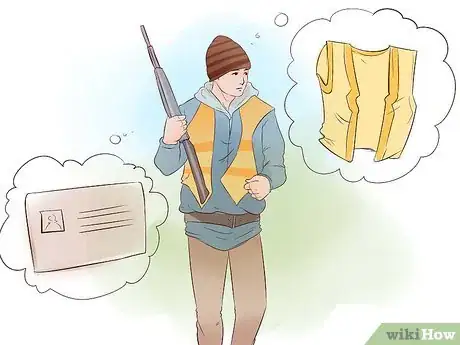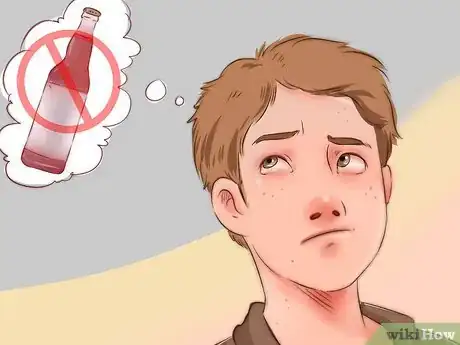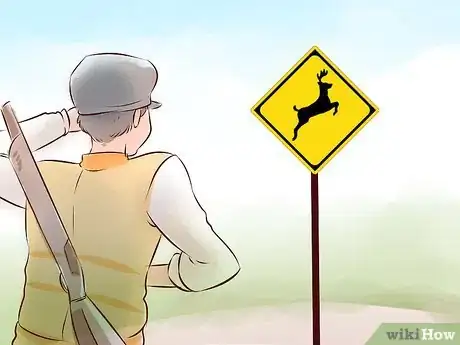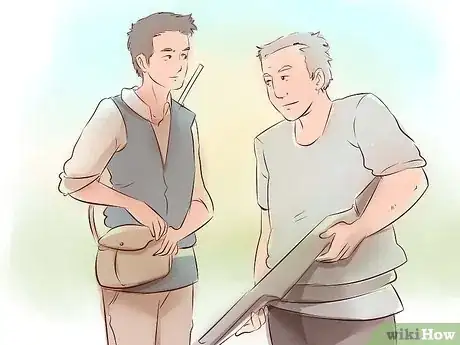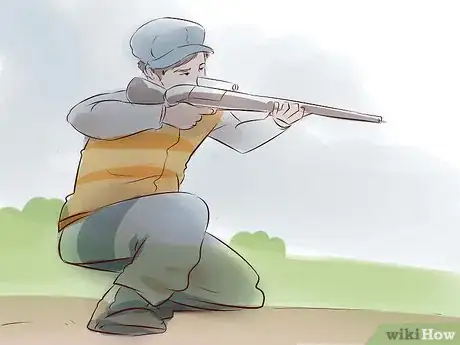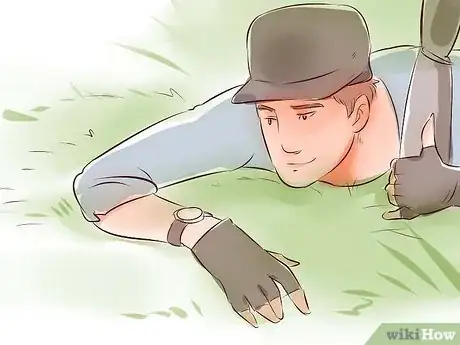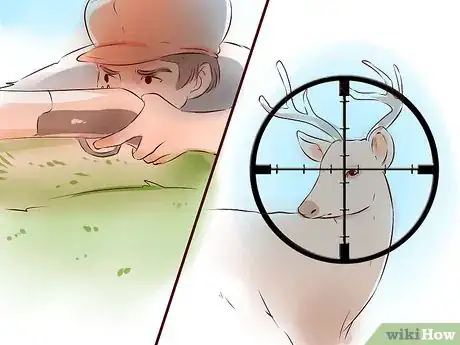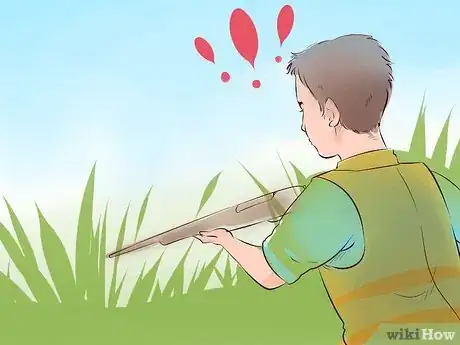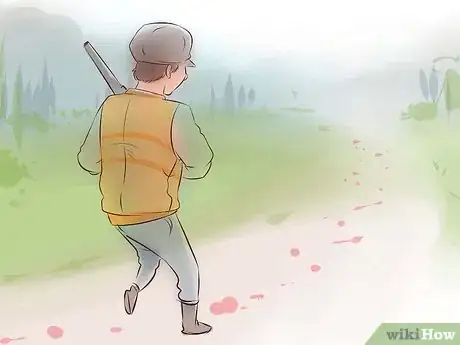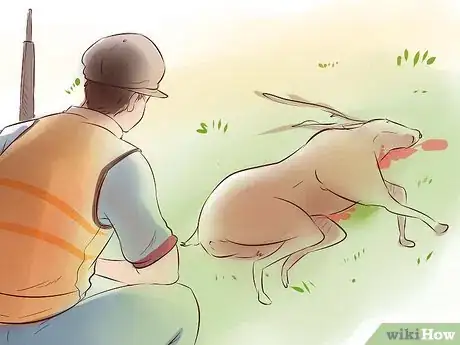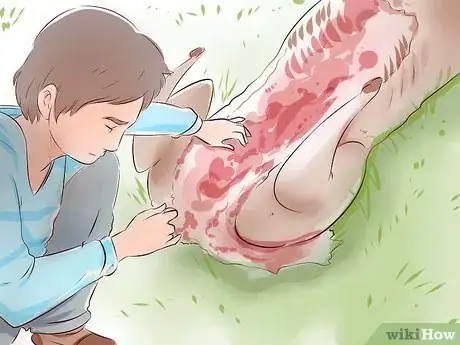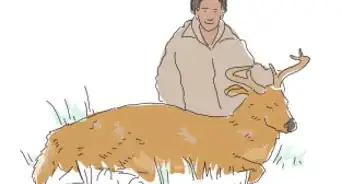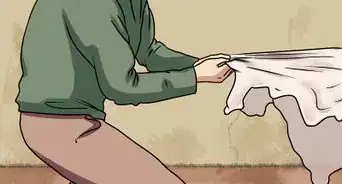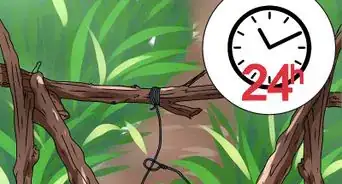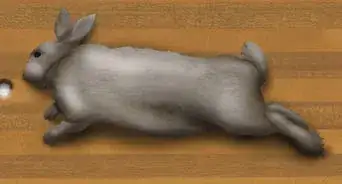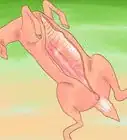wikiHow is a “wiki,” similar to Wikipedia, which means that many of our articles are co-written by multiple authors. To create this article, 37 people, some anonymous, worked to edit and improve it over time.
There are 17 references cited in this article, which can be found at the bottom of the page.
This article has been viewed 96,874 times.
Learn more...
Venison (deer meat) is an excellent source of lean animal protein and a healthy alternative to processed foods. Meat from wild animals with a plant-based diet is highly nutritious and hormone-free, and one deer can provide enough meat to last a whole human family for months.
A good hunter only needs one shot, and all hunters should endeavor to make each kill as quick and humane as possible. Whether you're an experienced hunter looking to get into deer hunting, or a total novice, you can learn to find a deer and make the most accurate and safe shot possible.
Steps
Finding Deer
-
1Get a hunting permit and the right equipment for the job. Visit the Department of National Resources website to learn more about the season for hunting deer in your area, as well as information about how to obtain a permit for the season, and areas in which you may hunt. Hunting deer without a permit and the proper equipment, or hunting deer out of season is always illegal. Generally, a seasonal permit for deer costs between $40-$100.
- For safety purposes, it's important to wear blaze orange to help distinguish yourself from the foliage, for other hunters who might be in the area.[1] Contrary to popular belief, deer can't see well enough to make camouflage particularly effective, though it is helpful in making your movements less visible, which are what alerts deer to your presence.
- Many different rifles are used for hunting deer, a .243 up to a 30-.06 or 30-30 caliber will do perfectly well for any deer you're likely to encounter. Hunting with shotguns is somewhat less common, though deer slugs are available for hunting deer.
- Bow hunting is also extremely common for hunting deer. In most areas, 45 pounds draw weight is the legal limit, which means you'll have a typical target distance from 20-60 yards.
-
2Pick a densely wooded area safe for hunting. Talk to local hunters and visit the website of the local Department of Wildlife or Department of Natural Resources to learn about public areas permissible for hunting. State and National park lands are sometimes made available at particular times for hunting deer.[2]
- It's also common to hunt on private property with the permission of the local landowners. If you know someone with good rural deer-hunting property, get in touch and ask if you can come out next season.
- Never assume an area is safe for hunting if you're not sure. Never trespass on private land without the permission of the landowners.
Advertisement -
3Mask your scent. While your smell may seem insignificant in the woods, scent control is a big concern when you're hunting deer. Ideally, you want to avoid using scented soaps, deodorant, and being around any strong perfume-like smells for 24-48 hours prior to a hunt. It's common to avoid showering for a day or two before going hunting.[3]
- Keep jackets and clothing in Rubbermaid containers with spruce bows to make you smell like the woods.
- No drinking alcohol or eating fatty foods the night before hunting, so you're not exuding strong smells that will alert deer to your presence.
- Some hunters will layer baking soda in between layers of hunting clothing to try to mask their scent further.
-
4Look for signs of deer. When you head out hunting, it's usually common to wander for a while and look for an ideal deer spot and set up camp to wait. You want to find evidence of a heavily travelled trail, preferably one that leads to an open area or meadow, depending on the weapons lethal distance.[4]
- Keep an eye out for deer-friendly food sources, like apples or corn, as well as available water sources where deer are likely to congregate.
- Ideally, a field about 60 yards (55 m) in diameter would be perfect for hunting deer. If you have a longer range rifle with an accurate, sighted-in scope, a larger meadow (300 yds long or so) would be desirable.
- One of the most obvious signs of the presence of deer is antler rub on trees, which is done by bucks to mark territory and share scent.[5]
-
5Find a camouflaged position. When you've found an ideal spot for hunting, set up camp and get to work making the deer come to you. There are lots of different ideas about how to camouflage yourself. Tree stands and blinds can be used in areas where game is likely to pass, but the thrill of tracking and sneaking up on a deer effectively is prized among certain hunters, who prefer to find cover in the wild. The choice is up to you.[6]
- Make the deer come to you. Deer calls, estrus spray, urine, and rattling antlers are all common ways of attracting deer to your position, especially early in the season.
-
6Go with a partner or two. Solo hunting can be dangerous and difficult, and it's always recommended that you go hunting with at least one other person. Packing out a whole deer by yourself is a challenge for even the strongest hunters, and the whole job is made easier and more fun with other experienced hunters to help the process along.
- Always let someone else know where you're going hunting, and when you're likely to return for safety purposes, especially if you'll be out of cellphone range.
- Don't bring dogs when hunting deer. Although they're good to have around when hunting fowl and other birds, dogs are too loud and will only serve to scare off deer.
Making the Shot
-
1Practice your shooting positions beforehand. There are a variety of positions from which it is possible to make an accurate shot, and a good hunter needs to be comfortable in all of them.[7] Practice getting into position in a safe place with an unloaded gun, well before you go out hunting.
- Prone position is the most stable, but it is the most difficult and impractical position to get into in the field,[8] while standing is the simplest, fastest, and unfortunately most unstable. Crouching or sitting positions are the most comfortable and stable positions for shooting deer accurately, if done properly.
- You can crouch quickly, supporting your elbow with your knee or thigh, making your aim more true and stable. In the sitting position, you'll sit cross-legged, perpendicular to your target, with the knee of your non-shooting hand pointing toward the target.
-
2Be patient. Hunting deer is usually an all-day activity, not something to do when you're rushed or impatient. Find a good spot to sit in wait when you go out hunting, and give it some time. Deer are more likely to come around an area that's been silent and still for quite a while, so be extremely quiet as you do so.
- Some hunters like to give a spot a couple hours then move around some, while others like to roam more or less constantly. It's your choice how you want to hunt, but most successful hunters do some combination of setting up to wait and trying out different areas.
- The waiting is part of the thrill and the drama of the hunt. If it wasn't challenging, nobody would bother.
-
3Wait until the deer is broadside. If you've spotted a deer, don't start pulling the trigger just yet. Use binoculars to look for signs of deer coming into the area and wait until one orients itself to your position in a way that offers you a clean shot. This is the most critical moment of the hunt, and the last thing you want to rush.
- Depending on the laws in your area and the type of permit you've acquired, take a minute to verify that the deer you're seeing is legal. Often, only bucks displaying a certain amount of antler growth (usually six points) are legal to harvest, though this varies from region to region.[9]
- If the first deer you see isn't legal, don't shoo it off. Wait. Deer often travel in pairs or herds and there are likely to be more deer coming soon.
-
4Take aim. As you wait for the deer to orient itself to you, pull your rifle into position and obtain a good sight picture, aligning your eye with the sight of the rifle. While it would be most ideal (both in order to minimize suffering and maximize the quality of the meat) to make a shot that kills the deer instantaneously, one should not automatically expect that it will happen that way. [10] While it's most common to aim for the heart or just behind the shoulder of the deer, there are a variety of philosophies regarding where, specifically, you should aim on a deer, so the pros and cons of each spot follow:
- Behind the front leg, 5-7 in. up from the chest is probably the most popular spot to aim. This shot will penetrate the heart and lungs, though deer don't always go down immediately with this shot, and will sometimes recover, meaning that you often have to do some tracking.
- The head, through the brain, offers an instant kill, and there is very little meat lost to a head shot. Typically, you'll aim just behind the eye to make this shot, a fairly advanced and difficult shot to make, with the potential for missing completely.[11] It also renders the deer impossible to taxidermy for a trophy, if you're interested in saving the antlers or the whole head.
- The neck, through the spine, is another popular and lethal spot, hit by aiming just behind the jawline of a deer showing you its broadside. This shot will often paralyze a deer, requiring a second shot or throat slit to finish the job, making it slightly less desirable.
-
5Remember the BRASS rule of shooting. Once you've taken aim, you need to breathe, relax, and ensure that you make the most accurate shot possible. Switch the safety off your rifle and get ready to shoot. The most accurate and controlled moment to squeeze the trigger is the moment immediately following an exhale, so don't hold the rifle in place for too long, or you'll start to sway. Do it swiftly, carefully, and efficiently. BRASS is an acronym that will help you remember the procedure:[12]
- Breathe
- Relax
- Aim
- Stop breathing
- Squeeze the trigger
-
6Never fire at anything you can't see. Make sure you are 100% certain that what you're shooting at is a deer. Many hunting accidents happen because people don't get a clear picture of whatever it is they're going to shoot at. It's too late by the time you pull the trigger.
- It's also important to be aware of your surroundings, so you know what's behind the deer as well. You don't want to be shooting towards another person, a private residence, a public road, or other places you wouldn't shoot.
Tracking the Deer
-
1Wait a few minutes. Wherever you've shot the deer, it will often take off, bounding away. It's important to wait a few minutes and not immediately charge after the deer, which can give the deer and adrenaline jolt, making the tracking job much more difficult. If you made a good shot, it won't get far and will lay down to die quickly, so waiting a few minutes won't make a bit of difference.
- Take care to remember the general spot you made the hit and the general direction that the deer took off. Mark the spot on your GPS if necessary.
-
2Find the blood at the original spot. Head to the spot the deer stood when you shot it and examine the ground for signs of blood, then pick up the trail. You can also check out the quality of the blood for signs of how accurate your shot was.[13]
- If you see thin blood, or bile on the ground, you missed your shot and you'll likely have to track the deer quickly to make a more humane kill. A gut-shot deer will take a long time to die, so you've got a responsibility to find it and speed up the process.
-
3Follow the blood through the foliage. Deer move quickly, even when wounded, and it's possible for them to cover quite a bit of ground after being shot mortally. You may have to off-road it a bit, but if you've made an accurate shot, you shouldn't have to follow for more than a few hundred yards at most. It's important to examine the ground and foliage up off the ground for blood and follow the deer's trail.[14]
- Some hunters like to use a bit of hydrogen peroxide to spray around foliage if the blood proves difficult to spot at any point. It should foam up and make the blood much more visible.
-
4Make sure the deer is dead. When you come up on the deer you've tracked, examine it closely from afar before you approach. Watch to see whether or not it is breathing, or moving. If you hit the deer in the chest, foamy blood is a good sign. That means you've probably penetrated the lungs, and the deer should die very quickly, if it's not dead already.[15]
- If the deer is still alive and doesn't seem close to death, approach it carefully, maintaining a safe distance, before taking a more accurate shot through the brain or chest and putting it down.
- Be extremely careful when approaching a wounded deer. Some hunters like to use a knife to slit the deer's throat and let it bleed out, though an angry, wounded deer with a big rack of antlers can be extremely dangerous.
-
5Field dress the deer properly.[16] As soon as the deer is dead, you should get to work field-dressing the carcass for safe consumption and breaking it down to a manageable size for packing out, or heading back to camp.[17] Depending on where you are and how far out you are from where you're going, there are a variety of ways to approach the task.[18]
- A good-quality and well-sharpened hunting knife is an invaluable tool when you're out hunting. You don't want to have just made a kill and find out you're without tools.
- If you're close to home or camp, or have access to an ATV or other vehicle, you might bring the whole deer back and hoist it before skinning and gutting the deer.
- If you've got a long hike on foot, remove the entrails and pull the major organs from the rib cage, being careful not to puncture the stomach or intestines. There will be several membranes attaching the organs to the spine, which you'll also need to cut. Generally, most hunters will then "break" the hind quarters and the fore, to make the carcass more easy for packing out, then butcher it later.
Community Q&A
-
QuestionHow many times should I shoot a deer? Where is the best place to shoot a deer?
 Community AnswerIf the shot you made is good, you should need only one shot. The heart is located low in the chest just behind the front shoulder.
Community AnswerIf the shot you made is good, you should need only one shot. The heart is located low in the chest just behind the front shoulder. -
QuestionHow do I stay calm when I am worried about the gun kicking and being really loud?
 Community AnswerI would recommend getting a hunting guide, but they will probably let you load your gun as you are entering your hunting vicinity. Then you can put it down while you are silently staying in one spot. You can quietly lift up your gun if and when you start to see a deer approaching. Once it's been determined that you can make a safe shot, you will only need to click off the safety and squeeze the trigger.
Community AnswerI would recommend getting a hunting guide, but they will probably let you load your gun as you are entering your hunting vicinity. Then you can put it down while you are silently staying in one spot. You can quietly lift up your gun if and when you start to see a deer approaching. Once it's been determined that you can make a safe shot, you will only need to click off the safety and squeeze the trigger.
Warnings
- Make sure you read the hunting regulations and seasons for your area.⧼thumbs_response⧽
- If you are hunting with a bow and arrow, there is usually a longer season and fewer limitations on hunting location, but the same safety rules apply.⧼thumbs_response⧽
- Never keep your rifle loaded if you are not hunting or target shooting, but always handle your firearm as if it were loaded. It is your responsibility to always make sure that the gun is pointed in a safe direction - never at yourself, at another person, or in any direction where it would potentially be unsafe if it fired. Always keep your hand off the trigger until you are ready to shoot. If you are hunting with a more experienced person, do not fire your gun until you are given permission to do so.⧼thumbs_response⧽
Things You'll Need
- Rifle, shotgun, or bow. Some weapons are illegal to hunt deer with, so read up.
- Knife to field dress deer.
- Binoculars or scope.
- Orange clothing.
References
- ↑ https://www.mass.gov/service-details/wear-blaze-orange-during-hunting-season
- ↑ https://www.artofmanliness.com/articles/a-primer-on-deer-hunting/
- ↑ https://www.realworldsurvivor.com/2015/07/21/mask-scent-when-hunting-deer/
- ↑ http://www.startribune.com/reading-deer-trails-helps-choosing-a-hunting-location/129677478/
- ↑ http://www.outdoorlife.com/articles/hunting/2007/09/anatomy-rub-0
- ↑ https://www.qdma.com/9-ways-to-conceal-movement-while-hunting/
- ↑ https://www.hunter-ed.com/missouri/studyGuide/Rifle-Firing-Positions/202025_700136461/
- ↑ https://www.nrafamily.org/articles/2017/5/21/master-the-prone-shooting-position/
- ↑ https://www.maine.gov/ifw/hunting-trapping/hunting-laws/deer-hunting.html
- ↑ http://www.outdoorlife.com/blogs/big-buck-zone/2012/09/where-aim-kill-deer-one-shot
- ↑ https://www.outdoorlife.com/blogs/big-buck-zone/2012/09/where-aim-kill-deer-one-shot
- ↑ http://www.alpharubicon.com/leo/shootbrass.html
- ↑ https://www.outdoornews.com/2014/11/20/tips-for-tracking-deer-after-the-shot/
- ↑ https://www.outdoorlife.com/blogs/big-buck-zone/2012/07/how-find-wounded-deer
- ↑ https://www.liveoutdoors.com/hunting/244081-6-things-to-do-after-shooting-deer/
- ↑ https://huntfish.mdc.mo.gov/hunting-trapping/species/deer/deer-getting-started/field-dressing-your-deer
- ↑ https://www.hunter-ed.com/washington/studyGuide/Field-Dressing-a-Deer-Detailed-Instructions/20105001_700046905/
- ↑ https://www.liveoutdoors.com/hunting/244081-6-things-to-do-after-shooting-deer/
About This Article
Whether you’re an experienced hunter or a total novice, you can learn how to find and shoot deer safely and accurately. Before hunting deer, visit the Department of National Resources website to learn about deer hunting season, permits, and areas where you can hunt. When you go hunting, always wear blaze orange so you stand out in case there are other hunters around. After you spot a deer, wait until it orients itself toward you, then aim at its head, neck, shoulder, or behind its front leg and shoot. Before you approach the deer, wait a few minutes so it doesn't get scared and try to run off if it’s still alive. Then, track the blood trail until you find the deer. Watch to see if it’s breathing or moving before approaching it. If the deer is still alive, take a more accurate shot through it's brain or chest to put it down quickly. To learn how to field dress your deer, keep reading!
